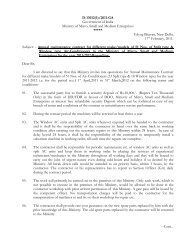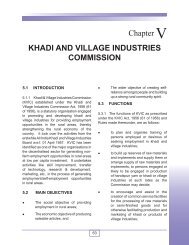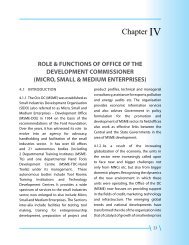Evaluation Study MSE Cluster Development - Ministry of Micro ...
Evaluation Study MSE Cluster Development - Ministry of Micro ...
Evaluation Study MSE Cluster Development - Ministry of Micro ...
Create successful ePaper yourself
Turn your PDF publications into a flip-book with our unique Google optimized e-Paper software.
Chapter No: 5– The Special Purpose Vehcile5.3 The Most Suitable Organizational and Legally RecognizedForm <strong>of</strong> the Special Purpose VehicleAs mentioned in the revised guidelines the SPV can be organized in several legallyrecognized forms such as a Cooperative Society, a Registered Society, a Trust, or aCompany. It is therefore essential to evolve a strong consensus among the clusteractors as to the organizational form most suitable for the specific cluster in conformitywith the nature and characteristics <strong>of</strong> the cluster. There is a fairly wide variation in thenature and characteristics <strong>of</strong> clusters. The varying nature <strong>of</strong> the clusters in terms <strong>of</strong>products, scale <strong>of</strong> operations, technology and processes, as well as markets determinethe needs and priorities <strong>of</strong> commonly shared facilities. It is therefore extremelyimportant to arrive at a common consensus on the organizational form that should beadopted to serve these needs most effectively. The nature <strong>of</strong> the common facilitiesrequired may also vary from cluster to cluster. Some may require a developmentalfacility, or quasi-developmental common facility, while others may need a commonprocessing, or testing facility that can best be developed and sustained on purelycommercial lines to ensure viability and pr<strong>of</strong>itability.Cooperatives and Registered Societies appear to be more suitable for clusters, whichhave a large number <strong>of</strong> small and micro enterprises with a limited scale <strong>of</strong> operations, alimited product range and limited financial capacities. These units are likely to be morelabour intensive predominantly employing family labour and requiring common facilitiesthat ensure quality and standardization, marketing support, and the collectiveprocurement <strong>of</strong> raw materials and other inputs.On the other hand there are clusters where both the scale <strong>of</strong> operations and the productrange is large and diverse. The units may be relatively larger with higher financialcapacities. These units are also likely to be more capital intensive requiring commontesting and processing facilities. These common facilities may have to be run on purelycommercial lines and run like any other normal enterprise involving sharing <strong>of</strong> pr<strong>of</strong>its andreinvestment in expanding these facilities. The SPV in the case <strong>of</strong> such clusters may bebest organized as private limited companies though in these cases the number <strong>of</strong> shareholders/enterprises would be statutorily limited. However it may be emphasized that inthe case <strong>of</strong> an SPV being registered as a private limited company the extent <strong>of</strong> benefitsand collective participation by cluster actors in general is likely to be limited and thetendency <strong>of</strong> monopolizing the facility for the benefit <strong>of</strong> a few dominant cluster membersis most likely. However even in this case wider participation and sharing <strong>of</strong> benefits ispossible if shares are held by a group <strong>of</strong> individual cluster members/enterprises, in theform <strong>of</strong> a ‘holding company’.In principle as the objectives <strong>of</strong> <strong>Cluster</strong> <strong>Development</strong> aims to promote inclusiveness <strong>of</strong>all cluster actors and the effective sharing <strong>of</strong> the benefits by the largest possible number<strong>of</strong> cluster actors it is desirable to ensure that the organizational form adopted isconducive to the maximum participation. The size and capacity <strong>of</strong> the common facility isnormally proposed on the basis <strong>of</strong> the number <strong>of</strong> cluster members who are ‘likely’ toutilize the facility, however if the organizational form adopted restricts the participationin the SPV and furthermore discriminates against the utilization <strong>of</strong> the common facility bythe non SPV members <strong>of</strong> the cluster, then the facility created for the cluster may be93
















